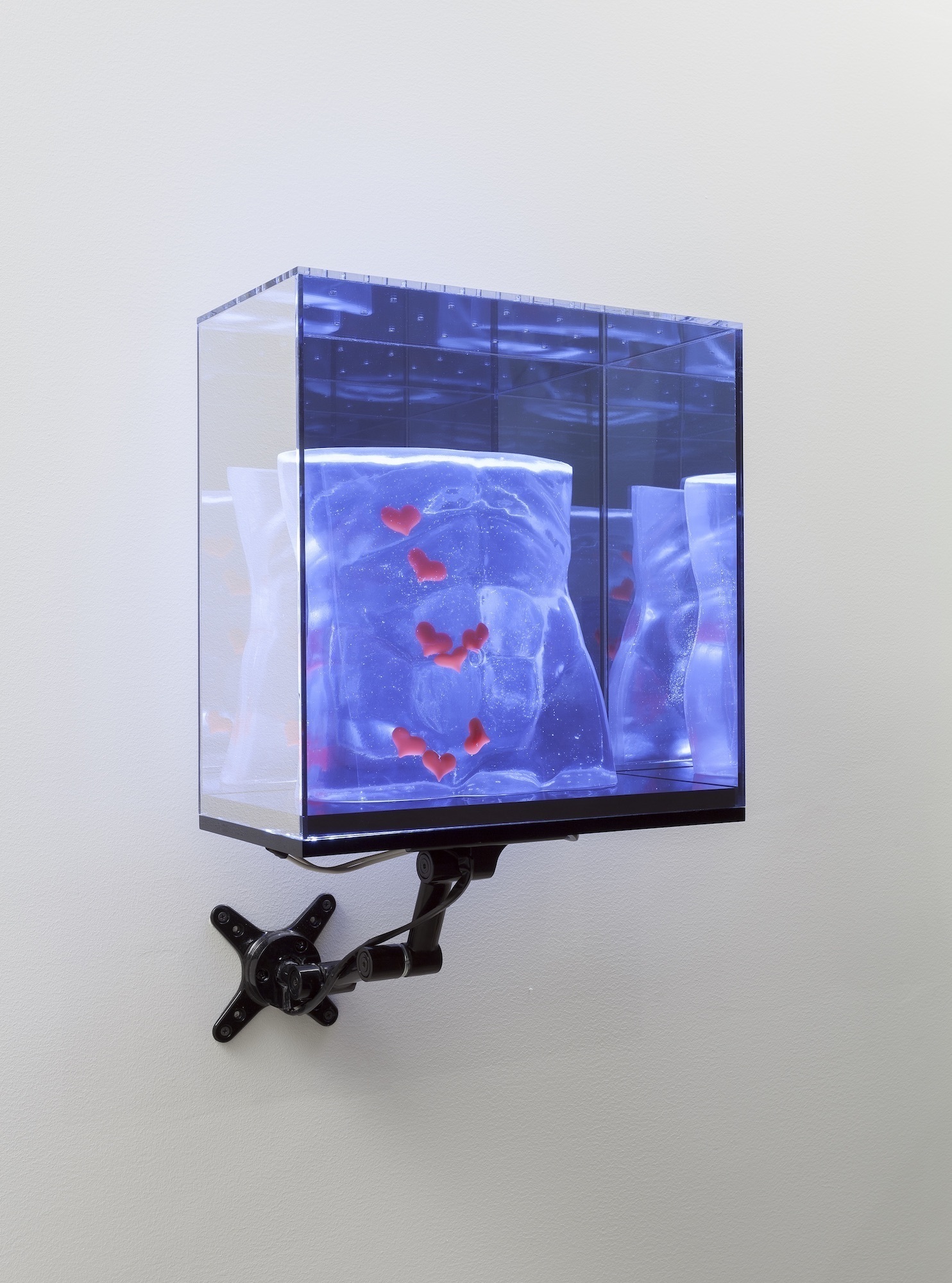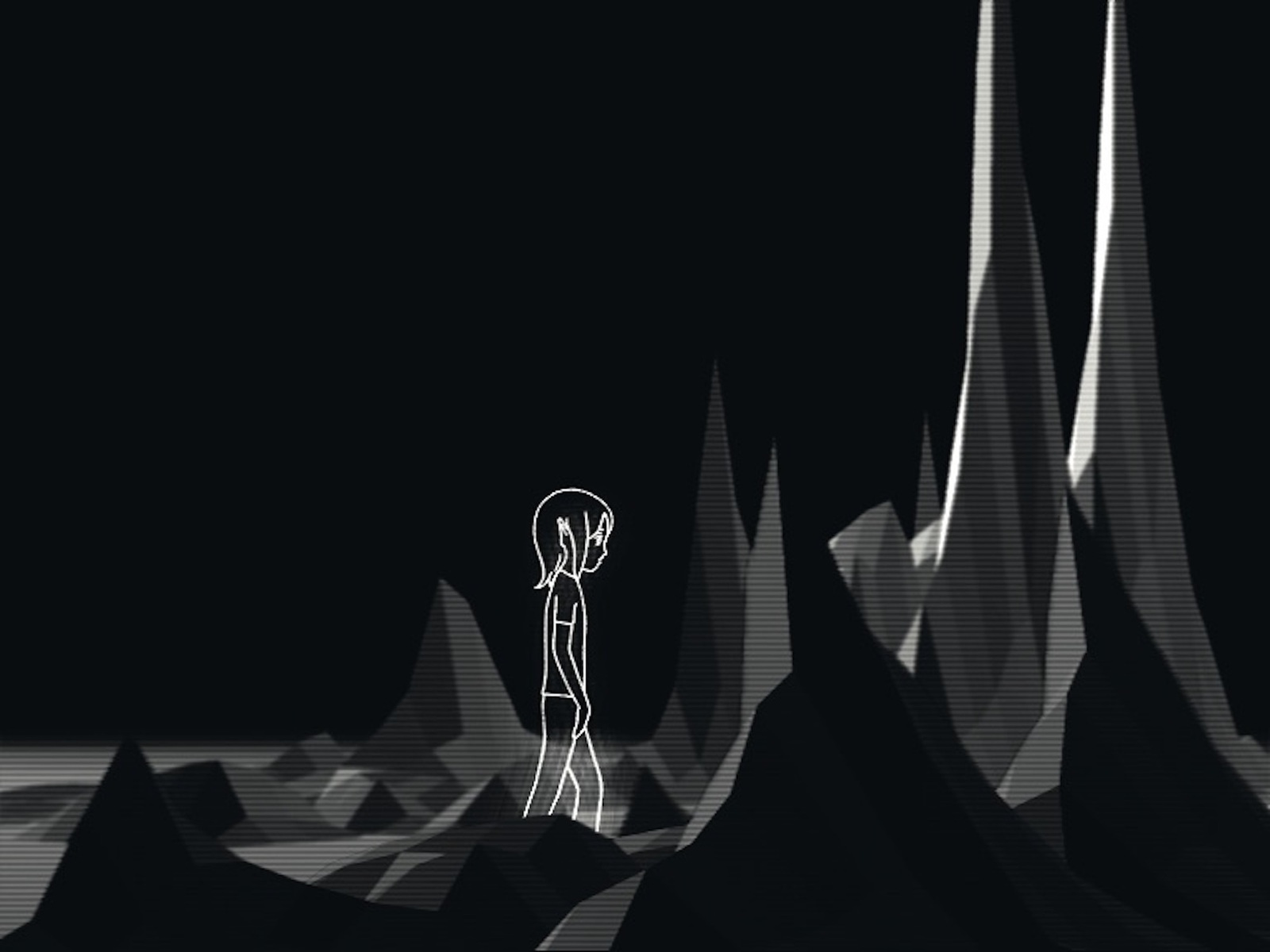It’s freezing in Seaport. The promises laid out by Helvetica font typefaces, primary colored condominium groups, and wide pedestrian ways can’t hide the fact that it’s fucking cold. My friend and I get off the Silverline. A minute later I’m holding the door for a British man with the bleached hair of a K-Pop idol, a comically red bomber jacket and black skinny jeans. Unlike him, I still haven’t figured out how to look cool or alternative or any kind of particular “look” in cold weather. For a millisecond I envy his constructed disarray, the primary color and the black managing to evoke what New York Magazine might call “Nordic Cool.”
My friend and I shiver ourselves over to the ICA. We hate this neighborhood, if that’s what it can be called. So do most of our friends. We pass “gather,” “honeygreen” and something else, bot-generated names that hang on the side of glass walls. All are gorgeous in their own way. They remind me of pretty people in fashion magazines, anatomical wonders I perceive as mechanical likely due to some unsubtle ressentiment. We aren’t sure if the Sorrelle store sells boots or artisanal coffee via a pop-up cafe; it probably doesn’t matter either way.
We get to the ICA, its warmth and movement providing physical relief from the yawning chill. It’s harbor market day. We look at artisanal candles, milky white and $24 a piece. Scents seemingly waft into our line of vision. It’s the bacon coated decadence of hundreds of stacked miniature Union Square Donuts, little jars of creme brulee maple syrup. A concession stand sells wasabi chex mix and pulled pork sliders. I wonder if this is a viable pairing. Everyone here is young and earnest, moving with a kind of programmed grace once they’ve shed the bulk of their outerwear.
Wangechi Mutu’s architectural sculpture looms over the scene. “A Promise to Communicate” is menacing as it is beautiful. Mutu’s global vision is presented as floating continents made of gray rescue blankets. One considers its construction and the gnarled chaos of 2018, utopian promises of the collective envisioned in brightly lit MIT classrooms, vague notions of the immiseration of Somewhere Else projected on a screen. It’s optimistic but perhaps foreboding about the impossibilities of communication in the current global order: one of immiserating power differentials. It’s a needfully heavy statement for the muted sunshine streaming through the lobby on a harbor market day; the visual impact of these structures can’t easily be missed.
I’d been dying to see “Art in the Age of the Internet,” the main attraction of the day. One of my preoccupations as of late has been the world of the immaterial made material, the impossible feedback between the two, the parodying of myself in Valley girl speak mixed with AIM chat logs. It’s almost a joke, me attending this exhibition, rhapsodizing and faux-cringing about my youth online, emo-kid Youtube communities lost to aggregation schemes, looking for grounding that isn’t eaten alive by papery aesthetic. I’ve been intellectualizing the narcissistic and myopic tendencies of the internet a lot lately, trying to trace the trajectories of celebrity and intimacy, rivers and tributaries of affect made fact and fact made affect.
Whenever I make jokes about being “v online”, I realize that my preoccupation is the product of a variety of interlaced forces. I’m worried about my financial future, I’m nostalgic for the kind of online idyll that made up the social structures of a younger me, I’m pissed off about the candied way in which brands and ideologies market 21st century insecurity as freedom. And in the midst of it, I and my peers are still trying to figure out the best way to represent ourselves, how to draw our lipstick on in the mirror and in film, whether to tweet about constructivism or eat a donut to seem relatable. I’m obsessed with the internet because it’s at least a repository by which we might start to know ourselves, overstimulated, undercompensated, incandescently eager and bitterly lonely. On a more macro scale, it also happens to be where desire gets monetized into capital markets, revolutions are stoked and reframed, where one can watch in real time, liquid absurdity transmogrifying into the radical and consequential.
The pieces in the exhibition cover a variety of different topics, from the geopolitic of surveillance, to the body and its representations, loneliness, alienation, pixelated anxiety, joy and red splattered mania. I’m in love with a lot of it. Camille Henrot’s “Grosse Fatigue” confronts the continual narrativization of the world. Taxidermied birds are stuffed in drawers and examined against too many Windows Explorer folders, Wikipedia opened up in browsers. I’m reminded of the anxiety of my own browsing habits, the entire canonized 21st Century accessible to me, the alarm of sounds echoing out of my laptop without source. A girl touches herself, the windows tessellate, nested like ripples in a pond. We document and dispose, make things permanent and watch them disappear. Creation is horrific and blase, violent and untouchable; as such, we’re all in need of some Sensory Self Care*.

Camille Henrot, Grosse Fatigue (Still), 2013. Courtesy the artist, Silex Films and Kamel Mennour, Paris/London. Copyright ADAGP Camille Henrot.
We move from seeing the entire world to considering the body and all its digitized, macabre possibilities. Ed Atkins’ “Safe Conduct” depicts the disposability of the organic body, the ease by which it can be mutilated by forces of capital and market mechanics. Dehumanized, the main figure passes his body parts through an airport security terminal, casual in his own deconstruction. The strings in the background of the video give it a manic quality,the grotesque soundtracked by something beautiful and familiar. In repetition, horror gives way to a numbing viewing experience, the product of looped imagery and storytelling.

Ed Atkins, Safe Conduct (Still), 2016.
Three-channel HD video (color, sound; 9:05 minutes)
Courtesy the artist and Gavin Brown’s Enterprise, New York/Rome. Copyright Ed Atkins.
In this next room, cartoon hearts are encased in plastic sculptures of the body, sublimated in clear sinewy form in Anicka Yi’s “Fever and Spear.” The body is crafted with surreal perfection, idealized notions of love and togetherness untouchable from the outside. It shines in the way of the etherized, a moth stuck to a wall for its weird and profound beauty. There’s something in its construction that feels effortless, crystalline and eerie.

Anicka Yi, Fever and Spear, 2014.
Resin, plastic hearts, two-way mirror, Plexiglas, and powder-coated steel wall mount
16 ½ × 16 × 8 inches (41.9 x 40.6 x 20.3 cm)
Courtesy the artist and 47 Canal, New York. Copyright Anicka Yi.
Pierre Huyghe’s “One Million Kingdoms” is a digitized girl on the surface of the moon, wandering alone through pixelated canyons. She wanders lonely, through a digitally produced emptiness, lost and despondent. Her two dimensionality provides the element of surreality, a kind of voyeurism whose emotional impact can’t be denied despite the fiction of it. She invokes pity and my own empathy, the hovering desire to take a pic captioned with #same. We get at the notion of personhood, of agency and emotive quality in the make-believe, the sketched out and created.

Pierre Huyghe, One Million Kingdoms (Still), 2001. Video (color, sound; 7:00 minutes) Courtesy the Artist and Marian Goodman Gallery, New York. Copyright Pierre Huyghe.
Artists in the exhibition also explore race and belonging, the body as policed and memed. The reimagination of the self is liberation in a world of consumable image. In “Untitled in the Rage (Nibiru Cataclysm),” Juliana Huxtable portrays her body in the way of the future, an image to be manipulated as a .jpeg file. The result is something blooming and freeing, a woman not subject to the everyday frustrations of living in one kind of body and the forces imposed on it. In washed green, the created self, the represented self finds a liminal space to be, in autonomy away from an unwelcome kind of gaze.

Juliana Huxtable, Untitled in the Rage (Nibiru Cataclysm), 2015.
Inkjet print
40 × 30 inches (101.6 × 76.2 cm).
Courtesy Solomon R. Guggenheim Museum, New York. Copyright, Juliana Huxtable.
As we come to the exhibition’s end there’s a virtual reality experience you can wait in line for.
I take a photo of a man who seems fully enraptured; the frame of the image captures a hollowed out shell of a constructed building. Afterwards, I post it on Instagram, with the caption “welcome 2 the seaport.” In my nervous way of editorializing, I’m worried that some of my more earnest friends will think I actually like the Seaport, so I change the caption to “welcome 2 the s e a p o r t,” which feels less ambiguous.
The exhibition is worth its MBTA ad space; the curation pulls off the ability to stare geopolitical meltdown in the face, coupled with the voyeuristic curiosity of a late night Omegle chatroom. It does the world of today justice in this combination and the general breadth of the work it presents.The self is not just flesh and blood, but trails of affect left behind, the archaeology of myspace backgrounds and typed out exclamations into the void. I might take issue with the honey-glazed rhetorical that is “How does the internet affect _____?” Lately, I don’t know if we can be parsed so cleanly; all the machinations of the systems governing our daily life exist virtually and physically. Inwardly, longings and warm-toned desires, are stretched out in virtual interfaces, superimposed and flicked around in light, sound and gaudy color. It’s not so much an additive relationship,or even a multiplicative one: love + the internet, the self x the internet. It’s a full immersion, a seamless continuity that defines life in 2018.
Afterwards, we emerge back into the neighborhood. I think about a monstrous future unfolding from this place, sprouting upwards in its glassy geometry. We look for a brewery afterwards and it starts to snow. It looks like Seattle, it looks like Los Angeles, it looks like everything and nothing, seen through the clear frame of a Warby Parker lens or the rendering of an iMac screen. We stay warm, huddled in consideration of the rest of our day.
The show is up until May 20th.
Admission is free on Thursday nights.
The ICA is located in the Seaport District.

